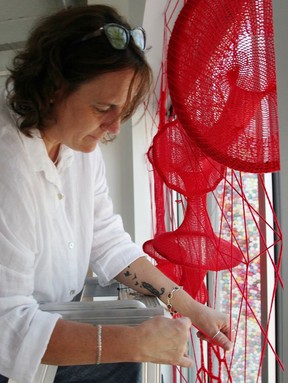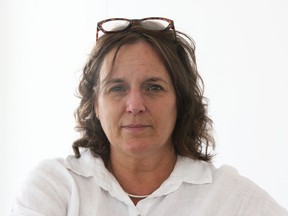Fourteen red-yarn tubes hanging in the Judith and Norman Alix Art Gallery until October will eventually be strung together in the treetops of a forest.
Tracey-Mae Chambers isn’t saying where exactly, and the Sarnia display is just a small sample of the tube totality she’s made for the eventual woodland installation.
“I think there’s 70-something,” said the Hamilton-based Métis sculptor who’s been crafting site-specific yarn artwork at venues across the country for about a year – and has dates booked into 2024 to continue her Hope and Healing Canada tour.
The installation in Sarnia is her 103rd so far, she said.
The yarn and metal ring work focuses on the connections between individuals, often represented by single threads, and the connections between communities and families, she said.
Those connections are necessary to decolonize public spaces like art galleries that often only don’t tell the stories of Indigenous people, or other traditionally marginalized groups, she said.

When suspected unmarked graves of children who died at a residential school in Kamloops, BC were found more than a year ago, reaction illustrated a disconnect between Indigenous and settler communities, she said.
That thousands of children died at residential schools had already been documented by the Truth and Reconciliation Commission, and was well known in Indigenous communities, she said.
“But it seemed like a big surprise to settlers in general, Canadians in general,” Chambers said. “I was weirded out by that. I didn’t realize there was such a deep disconnect between the two communities.”
Her artwork is about initiating conversations to improve connection and ensure Indigenous history, like the impact of Canada’s residential school system, isn’t ignored, she said.
“That’s essentially what the work is – illustrating that there is a connection between our communities but that it’s broken and the only people that can fix it is us.”
Red was chosen because it’s a racial slur, but also because it represents, power, passion, anger and blood, she said.
The artwork also speaks to the disconnect between people that happened during COVID-19, she said.

“So the work is always based on longing, geometric shapes and things like that, that are these structures that, if you cut one of those lines, that you no longer have that shape, that it falls apart.”
Her installation in the Sarnia gallery incorporates the height of the space’s windows and aims to represent “larger family groups and larger parts within a larger community,” she said.
A gallery talk with Chambers is planned Sept. 22 at 7 pm People can attend in person and it’ll be streamed via Zoom, curator Sonya Blazek said, noting the link will be available closer to the date at jnaag.ca.
The Aug. 5 to Oct. 1 Hope and Healing Canada installation will be lit in the evenings, she said, adding she’s pleased the gallery is hosting the show.
